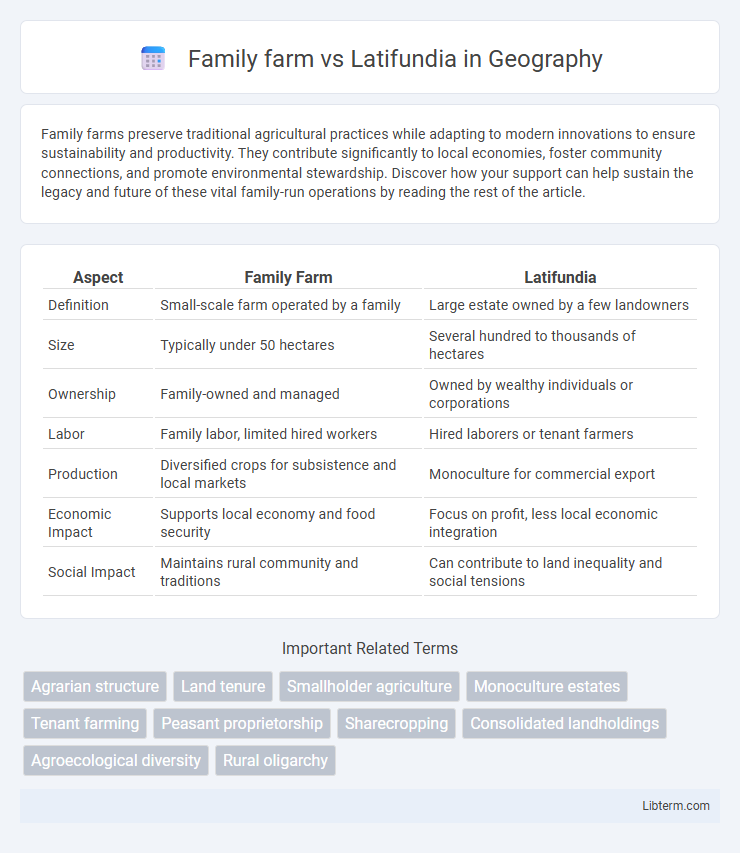Family farms preserve traditional agricultural practices while adapting to modern innovations to ensure sustainability and productivity. They contribute significantly to local economies, foster community connections, and promote environmental stewardship. Discover how your support can help sustain the legacy and future of these vital family-run operations by reading the rest of the article.
Table of Comparison
| Aspect | Family Farm | Latifundia |
|---|---|---|
| Definition | Small-scale farm operated by a family | Large estate owned by a few landowners |
| Size | Typically under 50 hectares | Several hundred to thousands of hectares |
| Ownership | Family-owned and managed | Owned by wealthy individuals or corporations |
| Labor | Family labor, limited hired workers | Hired laborers or tenant farmers |
| Production | Diversified crops for subsistence and local markets | Monoculture for commercial export |
| Economic Impact | Supports local economy and food security | Focus on profit, less local economic integration |
| Social Impact | Maintains rural community and traditions | Can contribute to land inequality and social tensions |
Defining Family Farms and Latifundia
Family farms are agricultural operations owned and managed by individuals or families, typically characterized by small to medium landholdings primarily aimed at subsistence or local markets. Latifundia are large estates or plantations controlled by wealthy landowners or corporations, often emphasizing commercial-scale production with extensive labor forces. These two models differ in scale, ownership structure, and economic focus, shaping rural social and economic landscapes distinctly.
Historical Origins and Development
Family farms originated in pre-industrial societies where small-scale, labor-intensive agriculture sustained local communities, emphasizing subsistence and kinship-based land ownership. Latifundia emerged in ancient Rome and later in colonial Latin America as large estates controlled by elites, prioritizing commercial agriculture and reliance on slave or forced labor. The development of family farms often reflects decentralized land tenure systems, while latifundia represent concentration of land and power, shaping distinct economic and social dynamics throughout history.
Land Ownership Structure
Family farms typically operate on smaller land parcels owned or directly managed by individuals or families, emphasizing personal stewardship and sustainable practices. Latifundia consist of vast estates controlled by a single owner or corporation, where land is often concentrated under elite ownership, leading to extensive monoculture and limited local benefit. The contrasting land ownership structures influence agricultural productivity, social dynamics, and rural development outcomes.
Economic Efficiency and Productivity
Family farms typically demonstrate higher economic efficiency and productivity per unit of land due to intensive labor, diverse crop production, and sustainable resource management practices. Latifundia, characterized by vast landholdings, often rely on extensive monoculture systems, which can lead to lower yield efficiency and increased reliance on mechanization and external inputs. The contrasting scale and management strategies influence overall economic outcomes, with family farms maximizing value through diversification and active stewardship while latifundia benefit from economies of scale but face challenges in optimizing land use intensity.
Social and Community Impact
Family farms foster strong community ties by promoting local employment, preserving rural traditions, and supporting sustainable land use, which strengthens social cohesion and economic resilience. Latifundia often contribute to social inequality and community fragmentation due to large-scale land concentration, limited local job opportunities, and environmental degradation. The contrasting social impacts of these agricultural models highlight the importance of land distribution in shaping community well-being and social equity.
Environmental Sustainability Practices
Family farms often implement diversified crop rotations and organic farming methods that enhance soil health and reduce chemical runoff, promoting long-term environmental sustainability. In contrast, latifundia systems typically rely on monoculture practices and intensive use of synthetic fertilizers and pesticides, which can lead to soil degradation, loss of biodiversity, and increased carbon emissions. Sustainable management on family farms includes integrated pest management and water conservation techniques, offering a model for reducing ecological footprints compared to large-scale agribusiness operations.
Labor Dynamics and Workforce
Family farms rely heavily on family labor, fostering multigenerational involvement and skill transfer, which enhances productivity and sustainability. Latifundia depend primarily on hired laborers or seasonal workers, creating a hierarchical workforce structure prone to labor exploitation and low wage rates. The labor dynamics in family farms emphasize personal investment and long-term stewardship, whereas latifundia prioritize mass production and efficiency through mechanization and labor segmentation.
Government Policies and Support
Government policies for family farms often include subsidies, access to credit, and technical assistance aimed at promoting sustainable agriculture and food security. In contrast, Latifundia benefit from policies that favor large-scale agribusiness investments, such as tax incentives and infrastructure development, which can lead to land concentration and reduced support for smallholders. Policy frameworks significantly influence land distribution, productivity, and rural livelihoods by either empowering family farms or reinforcing the dominance of Latifundia.
Challenges and Opportunities
Family farms face challenges such as limited access to capital, fluctuating market prices, and the impact of climate change on crop yields, yet they benefit from strong community ties and sustainable farming practices. Latifundia, characterized by large-scale landholdings, encounter issues with land inequality, labor exploitation, and environmental degradation, but they offer opportunities for economies of scale, mechanization, and increased agricultural output. Balancing productivity with social equity remains a critical challenge for both family farms and latifundia amidst global food security concerns.
Future Trends in Agriculture
Family farms are increasingly adopting precision agriculture and sustainable practices to enhance productivity and environmental stewardship, catering to local markets and organic produce demand. Latifundia, large-scale commercial estates, are integrating advanced technologies like AI-driven crop monitoring and automated machinery to maximize output and efficiency on extensive landholdings. Future trends suggest a convergence where family farms leverage digital tools typically used by latifundia, promoting resilient, climate-smart agriculture tailored to diverse regional needs.
Family farm Infographic

 libterm.com
libterm.com